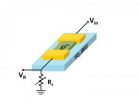(Press-News.org) Like a bouncer at an exclusive nightclub, the blood-brain barrier allows only select molecules to pass from the bloodstream into the fluid that bathes the brain. Vital nutrients get in; toxins and pathogens are blocked. The barrier also ensures that waste products are filtered out of the brain and whisked away.
The blood-brain barrier helps maintain the delicate environment that allows the human brain to thrive. There's just one problem: The barrier is so discerning, it won't let medicines pass through. Researchers haven't been able to coax it to open up because they don't know enough about how the barrier forms or functions.
Now, a team from Harvard Medical School has identified a gene in mice, Mfsd2a, that may beresponsible for limiting the barrier's permeability—and the molecule it produces, Mfsd2a, works in a way few researchers expected.
"Right now, 98 percent of small-molecule drugs and 100 percent of large-molecule drugs and antibodies can't get through the blood-brain barrier," said Chenghua Gu, associate professor of neurobiology at HMS and senior author of the study. "Less than 1 percent of pharmaceuticals even try to target the barrier, because we don't know what the targets are. Mfsd2a could be one."
Most attempts to understand and manipulate blood-brain barrier function have focused on tight junctions, seals that prevent all but a few substances from squeezing between barrier cells. Gu and her team discovered that Mfsd2a appears to instead affect a second barrier-crossing mechanism that has received much less attention, transcytosis, a process in which substances are transported through the barrier cells in bubbles called vesicles. Transcytosis occurs frequently at other sites in the body but is normally suppressed at the blood-brain barrier. Mfsd2a may be one of the suppressors.
"It's exciting because this is the first molecule identified that inhibits transcytosis," said Gu. "It opens up a new way of thinking about how to design strategies to deliver drugs to the central nervous system."
Because Mfsd2a has a human equivalent, blocking its activity in people could allow doctors to open the blood-brain barrier briefly and selectively to let in drugs to treat life-threatening conditions such as brain tumors and infections.
Conversely, because researchers have begun to link blood-brain barrier degradation to several brain diseases, boosting Mfsd2a or Mfsd2a could allow doctors to strengthen the barrier and perhaps alleviate diseases such as Alzheimer's, amyotrophic lateral sclerosis (ALS) and multiple sclerosis. The findings may also have implications for other areas of the body that rely on transcytosis, such as the retina and kidney.
The study was published May 14 in Nature.
Back to the beginning
As developmental biologists, Gu and her colleagues believed watching the barrier develop in young organisms would reveal molecules important for its formation and function.
The team introduced a small amount of dye into the blood of embryonic mice at different stages of development and watched whether it leaked through the walls of the tiny capillaries of the mice's brains, suggesting that the blood-brain barrier hadn't formed yet, or stayed contained within the capillaries, indicating that the barrier was doing its job. This allowed them to define a time window during which the barrier was being built.
The team was able to do this by devising a new dye injection technique. Researchers studying blood-brain barrier leakage in adult organisms can inject dye directly into blood vessels, but the capillaries of embryos are too small and delicate. Instead, researchers typically inject dye into the heart. However, according to Gu, this can raise blood pressure and burst brain capillaries, making it difficult to tell whether leakage is due to blood-brain barrier immaturity or the dye procedure itself. She and her team used theirvascular biology expertise to identify an alternate injection site that would avoid such artifacts: the liver.
"This allowed us to provide definitive evidence that the blood-brain barrier comes into play during embryonic development," said Ayal Ben-Zvi, a postdoctoral researcher in the Gu lab and first author of the study. "That changes our understanding of the development of the brain itself."
Telltale pattern
Now that they knew when the barrier formed in the mice, the team compared endothelial cells—the cells that line blood vessel walls and help form the blood-brain barrier—from peripheral blood vessels and cortical (brain) vessels and looked for differences in gene expression. They made a list of genes that were expressed only in the cortical endothelial cells. From thatlist, they validated about a dozen invivo.
The team could have studied any of the genes first, but they were most intrigued by Mfsd2a because of its expression pattern. In addition to being switched on in brain vessels, it was active in the placenta and testis, two other organs that have barrier-type functions. Also, the gene is shared across vertebrate organisms that have blood-brain barriers, including humans.
Gu and the team then conducted experiments in mice that lacked the Mfsd2a gene. They found that without Mfsd2a, the blood-brain barrier leaked (although it didn't prevent the blood vessels themselves from forming in the first place). The next question was why.
"We focused on two basic characteristics: tight junctions between cells, which prohibit passage of water-soluble molecules, and transcytosis, which happens all the time in peripheral vessels but very little in the cortical vessels," said Gu. "We found the surprising result that Mfsd2a regulates transcytosis without affecting tight junctions. This is exciting because conceptually it says this previously unappreciated feature may be even more important than tight junctions."
"At first we were looking at tight junctions, because we were also biased by the field," said Ben-Zvi, who will be starting his own lab later this year at The Hebrew University of Jerusalem. "We weren't finding anything on the electron micrographs even though we knew the vessels leaked. Then we noticed there were tons of vesicles.
"It really shows that if you do systematic science and see something strange, you shouldn't dismiss it, because maybe that's what you're looking for."
Next steps
The team also began to study the relationship between the cortical endothelial cells and another contributor to the blood-brain barrier, cells called pericytes. So far, they have found that pericytes regulate Mfsd2a. Next, they want to learn what exactly the pericytes are telling the endothelial cells to do.
Other future work in the Gu lab includes testing the dozen other potential molecular players and trying to piece together the entire network that regulates transcytosis in the blood-brain barrier.
"In addition to Mfsd2a, there may be several other molecules on the list that will be good drug targets," said Gu. "The key here is we are gaining tools to manipulate transcytosis either way: opening or tightening."
As important as the molecules themselves, she added, is the concept.
"I personally hope people in the blood-brain barrier field will consider the mind-shifting paradigm that transcytosis could be targeted or modulated," said Ben-Zvi.
Better understanding—and potentially being able to manipulate—the molecular underpinnings of transcytosis could aid in the study and treatment of diseases in tissues beyond the brain, from the intestines absorbing nutrients to the kidneys filtering waste.
Being able to open and close the blood-brain barrier also promises to benefit basic research, enabling scientists to investigate how abnormal barrier formation affects brain development and what the relationship may be between barrier deterioration and disease.
INFORMATION:
This work was supported by NIH grants R01NS064583 and 5T32MH20017-15, a Sloan Research Fellowship, an Armenise junior faculty award, the Genise Goldenson fund and the Freudenberger award.
Written by Stephanie Dutchen
Harvard Medical School has more than 7,500 full-time faculty working in 11 academic departments located at the School's Boston campus or in one of 47 hospital-based clinical departments at 16 Harvard-affiliated teaching hospitals and research institutes. Those affiliates include Beth Israel Deaconess Medical Center, Brigham and Women's Hospital, Cambridge Health Alliance, Boston Children's Hospital, Dana-Farber Cancer Institute, Harvard Pilgrim Health Care, Hebrew Senior Life, Joslin Diabetes Center, Judge Baker Children's Center, Massachusetts Eye and Ear Infirmary, Massachusetts General Hospital, McLean Hospital, Mount Auburn Hospital, Schepens Eye Research Institute, Spaulding Rehabilitation Hospital and VA Boston Healthcare System.
Possible new plan of attack for opening and closing the blood-brain barrier
Little-studied mechanism offers much-needed new avenue for attempting drug delivery
2014-05-14
ELSE PRESS RELEASES FROM THIS DATE:
Tropical cyclone 'maximum intensity' is shifting toward poles
2014-05-14
Over the past 30 years, the location where tropical cyclones reach maximum intensity has been shifting toward the poles in both the northern and southern hemispheres at a rate of about 35 miles, or one-half a degree of latitude, per decade according to a new study, The Poleward Migration of the Location of Tropical Cyclone Maximum Intensity, published tomorrow in Nature.
As tropical cyclones move into higher latitudes, some regions closer to the equator may experience reduced risk, while coastal populations and infrastructure poleward of the tropics may experience increased ...
Researchers discover how DHA omega-3 fatty acid reaches the brain
2014-05-14
It is widely believed that DHA (docosahexaenoic acid) is good for your brain, but how it is absorbed by the brain has been unknown. That is - until now. Researchers from Duke-NUS Graduate Medical School Singapore (Duke-NUS) have conducted a new study identifying that the transporter protein Mfsd2a carries DHA to the brain. Their findings have widespread implications for how DHA functions in human nutrition.
People know that DHA is an essential dietary nutrient that they can get from seafood and marine oils. Baby formula companies are especially attuned to the benefits ...
California mountains rise as groundwater depleted in state's Central Valley
2014-05-14
Winter rains and summer groundwater pumping in California's Central Valley make the Sierra Nevada and Coast Ranges sink and rise by a few millimeters each year, creating stress on the state's earthquake faults that could increase the risk of a quake.
Gradual depletion of the Central Valley aquifer because of groundwater pumping also raises these mountain ranges by a similar amount each year – about the thickness of a dime – with a cumulative rise over the past 150 years of up to 15 centimeters (6 inches), according to calculations by a team of geophysicists.
While the ...
CEBAF beam goes over the hump: Highest-energy beam ever delivered at Jefferson Lab
2014-05-14
The Continuous Electron Beam Accelerator Facility (CEBAF) at the U.S. Department of Energy's Thomas Jefferson National Accelerator Facility has achieved the final two accelerator commissioning milestones needed for approval to start experimental operations following its first major upgrade.
In the early hours of May 7, the machine delivered its highest-energy beams ever, 10.5 billion electron-volts (10.5 GeV) through the entire accelerator and up to the start of the beamline for its newest experimental complex, Hall D. Then, in the last minutes of the day on May 7, the ...
Who should be saved? Study gets diverse MD community views on healthcare disaster planning
2014-05-14
BALTIMORE—In the event of a flu pandemic, who should have priority access to life-saving ventilators, and who should make that determination? Few disaster preparedness plans have taken community values regarding allocation into account, but a new study is aiming to change that through public engagement with Maryland residents.
"In the event of a healthcare crisis, understanding the community perspective and having citizen buy-in will be critical to avoid compounding the initial disaster with further social upheaval," says principal investigator Elizabeth L. Daugherty ...
Strongly interacting electrons in wacky oxide synchronize to work like the brain
2014-05-14
Current computing is based on binary logic -- zeroes and ones -- also called Boolean computing, but a new type of computing architecture stores information in the frequencies and phases of periodic signals and could work more like the human brain using a fraction of the energy necessary for today's computers, according to a team of engineers.
Vanadium dioxide is called a "wacky oxide" because it transitions from a conducting metal to an insulating semiconductor and vice versa with the addition of a small amount of heat or electrical current. A device created by electrical ...
Research shows hope for normal heart function in children with fatal heart disease
2014-05-14
DETROIT, Mich., - After two decades of arduous research, a National Institutes of Health (NIH)-funded investigator at the Children's Hospital of Michigan (CHM) at the Detroit Medical Center (DMC) and the Wayne State University School of Medicine has published a new study showing that many children with an often fatal type of heart disease can recover "normal size and function" of damaged sections of their hearts.
The finding by Children's Hospital of Michigan's Pediatrician-in-Chief and Wayne State University Chair of Pediatrics Steven E. Lipshultz, M.D., F.A.A.P., F.A.H.A., ...
Study finds free fitness center-based exercise referral program not well utilized
2014-05-14
Eliminating financial barriers to a fitness center as well as providing physician support, a pleasant environment and trained fitness staff did not result in widespread membership activation or consistent attendance among low income, multi-ethnic women with chronic disease risk factors or diagnoses according to a new study from Boston University School of Medicine. The findings, published in Journal of Community Health, is believed to be the first study of its kind to examine patient characteristics associated with utilization of community health center- based exercise ...
Study finds outcome data in clinical trials reported inadequately, inconsistently
2014-05-14
Philadelphia, May 14, 2014 – There is increasing public pressure to report the results of all clinical trials to eliminate publication bias and improve public access. However, investigators using the World Health Organization's International Clinical Trials Registry Platform (ICTRP) to build a database of clinical trials involving chronic pain have encountered several challenges. They describe the perils and pitfalls of using the ICTRP and propose alternative strategies to improve clinical trials reporting. This important and insightful study is published in the August ...
Enzyme helps stem cells improve recovery from limb injuries
2014-05-14
AUGUSTA, Ga. – While it seems like restoring blood flow to an injured leg would be a good thing, it can actually cause additional damage that hinders recovery, researchers say.
Ischemia reperfusion injury affects nearly two million Americans annually with a wide variety of scenarios that temporarily impede blood flow – from traumatic limb injuries, to heart attacks, to donor organs, said Dr. Babak Baban, immunologist at the Medical College of Georgia and College of Dental Medicine at Georgia Regents University.
Restoring blood flow actually heightens inflammation ...
LAST 30 PRESS RELEASES:
Making lighter work of calculating fluid and heat flow
Normalizing blood sugar can halve heart attack risk
Lowering blood sugar cuts heart attack risk in people with prediabetes
Study links genetic variants to risk of blinding eye disease in premature infants
Non-opioid ‘pain sponge’ therapy halts cartilage degeneration and relieves chronic pain
AI can pick up cultural values by mimicking how kids learn
China’s ecological redlines offer fast track to 30 x 30 global conservation goal
Invisible indoor threats: emerging household contaminants and their growing risks to human health
Adding antibody treatment to chemo boosts outcomes for children with rare cancer
Germline pathogenic variants among women without a history of breast cancer
Tanning beds triple melanoma risk, potentially causing broad DNA damage
Unique bond identified as key to viral infection speed
Indoor tanning makes youthful skin much older on a genetic level
Mouse model sheds new light on the causes and potential solutions to human GI problems linked to muscular dystrophy
The Journal of Nuclear Medicine ahead-of-print tip sheet: December 12, 2025
Smarter tools for peering into the microscopic world
Applications open for funding to conduct research in the Kinsey Institute archives
Global measure underestimates the severity of food insecurity
Child survivors of critical illness are missing out on timely follow up care
Risk-based vs annual breast cancer screening / the WISDOM randomized clinical trial
University of Toronto launches Electric Vehicle Innovation Ontario to accelerate advanced EV technologies and build Canada’s innovation advantage
Early relapse predicts poor outcomes in aggressive blood cancer
American College of Lifestyle Medicine applauds two CMS models aligned with lifestyle medicine practice and reimbursement
Clinical trial finds cannabis use not a barrier to quitting nicotine vaping
Supplemental nutrition assistance program policies and food insecurity
Switching immune cells to “night mode” could limit damage after a heart attack, study suggests
URI-based Global RIghts Project report spotlights continued troubling trends in worldwide inhumane treatment
Neutrophils are less aggressive at night, explaining why nighttime heart attacks cause less damage than daytime events
Menopausal hormone therapy may not pose breast cancer risk for women with BRCA mutations
Mobile health tool may improve quality of life for adolescent and young adult breast cancer survivors
[Press-News.org] Possible new plan of attack for opening and closing the blood-brain barrierLittle-studied mechanism offers much-needed new avenue for attempting drug delivery



